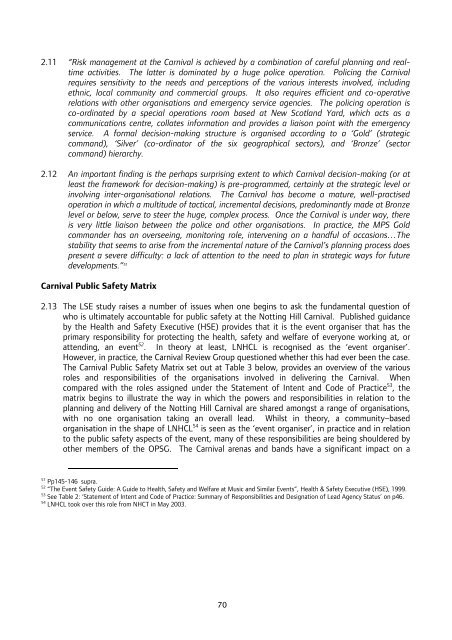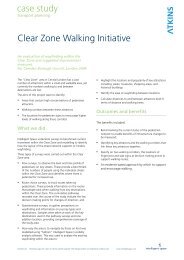Notting Hill Carnival Strategic Review - Intelligent Space
Notting Hill Carnival Strategic Review - Intelligent Space
Notting Hill Carnival Strategic Review - Intelligent Space
Create successful ePaper yourself
Turn your PDF publications into a flip-book with our unique Google optimized e-Paper software.
2.11 “Risk management at the <strong>Carnival</strong> is achieved by a combination of careful planning and realtime<br />
activities. The latter is dominated by a huge police operation. Policing the <strong>Carnival</strong><br />
requires sensitivity to the needs and perceptions of the various interests involved, including<br />
ethnic, local community and commercial groups. It also requires efficient and co-operative<br />
relations with other organisations and emergency service agencies. The policing operation is<br />
co-ordinated by a special operations room based at New Scotland Yard, which acts as a<br />
communications centre, collates information and provides a liaison point with the emergency<br />
service. A formal decision-making structure is organised according to a ‘Gold’ (strategic<br />
command), ‘Silver’ (co-ordinator of the six geographical sectors), and ‘Bronze’ (sector<br />
command) hierarchy.<br />
2.12 An important finding is the perhaps surprising extent to which <strong>Carnival</strong> decision-making (or at<br />
least the framework for decision-making) is pre-programmed, certainly at the strategic level or<br />
involving inter-organisational relations. The <strong>Carnival</strong> has become a mature, well-practised<br />
operation in which a multitude of tactical, incremental decisions, predominantly made at Bronze<br />
level or below, serve to steer the huge, complex process. Once the <strong>Carnival</strong> is under way, there<br />
is very little liaison between the police and other organisations. In practice, the MPS Gold<br />
commander has an overseeing, monitoring role, intervening on a handful of occasions…The<br />
stability that seems to arise from the incremental nature of the <strong>Carnival</strong>’s planning process does<br />
present a severe difficulty: a lack of attention to the need to plan in strategic ways for future<br />
developments.” 51<br />
<strong>Carnival</strong> Public Safety Matrix<br />
2.13 The LSE study raises a number of issues when one begins to ask the fundamental question of<br />
who is ultimately accountable for public safety at the <strong>Notting</strong> <strong>Hill</strong> <strong>Carnival</strong>. Published guidance<br />
by the Health and Safety Executive (HSE) provides that it is the event organiser that has the<br />
primary responsibility for protecting the health, safety and welfare of everyone working at, or<br />
attending, an event 52 . In theory at least, LNHCL is recognised as the ‘event organiser’.<br />
However, in practice, the <strong>Carnival</strong> <strong>Review</strong> Group questioned whether this had ever been the case.<br />
The <strong>Carnival</strong> Public Safety Matrix set out at Table 3 below, provides an overview of the various<br />
roles and responsibilities of the organisations involved in delivering the <strong>Carnival</strong>. When<br />
compared with the roles assigned under the Statement of Intent and Code of Practice 53 , the<br />
matrix begins to illustrate the way in which the powers and responsibilities in relation to the<br />
planning and delivery of the <strong>Notting</strong> <strong>Hill</strong> <strong>Carnival</strong> are shared amongst a range of organisations,<br />
with no one organisation taking an overall lead. Whilst in theory, a community–based<br />
organisation in the shape of LNHCL 54 is seen as the ‘event organiser’, in practice and in relation<br />
to the public safety aspects of the event, many of these responsibilities are being shouldered by<br />
other members of the OPSG. The <strong>Carnival</strong> arenas and bands have a significant impact on a<br />
51<br />
Pp145-146 supra.<br />
52<br />
“The Event Safety Guide: A Guide to Health, Safety and Welfare at Music and Similar Events”, Health & Safety Executive (HSE), 1999.<br />
53<br />
See Table 2: ‘Statement of Intent and Code of Practice: Summary of Responsibilities and Designation of Lead Agency Status’ on p46.<br />
54<br />
LNHCL took over this role from NHCT in May 2003.<br />
70








